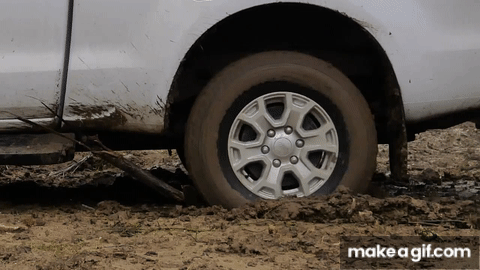Harikesh_33
- 24
- 4
- Homework Statement
- So these are few questions my prof has asked us to try answering :
Examine through the lens of Frictional forces and rolling with and without Slipping and Sliding as to
1)what happens when a car wheel is stuck in a mud and finds it hard to get out of the mud .
2)what happens to a wheel in an incline .
3)what happens to a wheel when it's rolling without Slipping
- Relevant Equations
- 1)$v_{cm}$=$Rω$ (rolling without Slipping).
2)$v_{cm}$>$Rω$ (rolling with sliding) .
3)$v_{cm}$<$Rω$ (rolling with slipping) .
4)$τ_{friction}$=$R×F_f$(F_f ca be either kinetic or static friction based on the situation)
1)When a wheel is stuck in mud it rolls with slipping ,this means that at the point of contact it has a net velocity

As we can see from the image Kinetic Friction acts in the direction opposite to the resultant velocity ,this effectively reduces the tangential velocity at the surface and tries to brings it to Rolling without Slipping condition.Now can you tell me what happens after that ?Does the wheel get out of the mud ? I know that once the relative velocity betweent the wheel and surface becomes zero.Static friction sets in ,do I have to achieve Rolling with Sliding to get out of the mud ?2)
 If I am not mistaken the job of Static Friction is to make sure that the Rolling without Slipping or sliding is maintained .Now if the net force is non zero then it means that there is an acceleration of Centre of mass ,Now there is a Torque due to Static Friction ,this causes an angular acceleration α ,this leads to an acceleration of its own ,now the condition for rolling without Slipping /Sliding is that $a_{cm}=Rα$ (where $a_{cm}$ is the acceleration due to Force in x direction ,α is the acceleration due to the angular acceleration ,when $a_{cm}>Rα$ then Rolling with Sliding happens .
If I am not mistaken the job of Static Friction is to make sure that the Rolling without Slipping or sliding is maintained .Now if the net force is non zero then it means that there is an acceleration of Centre of mass ,Now there is a Torque due to Static Friction ,this causes an angular acceleration α ,this leads to an acceleration of its own ,now the condition for rolling without Slipping /Sliding is that $a_{cm}=Rα$ (where $a_{cm}$ is the acceleration due to Force in x direction ,α is the acceleration due to the angular acceleration ,when $a_{cm}>Rα$ then Rolling with Sliding happens .
3)When a wheel is Rolling without Slipping the relative velocity is zero ,which mean Static friction exists ,now for the wheel to move in Rolling with Slipping or Sliding the acceleration produced due to the angular acceleration caused by the Torque, should be less than acceleration of the Centre of Mass .
I would love to hear your thoughts on my answer .
As we can see from the image Kinetic Friction acts in the direction opposite to the resultant velocity ,this effectively reduces the tangential velocity at the surface and tries to brings it to Rolling without Slipping condition.Now can you tell me what happens after that ?Does the wheel get out of the mud ? I know that once the relative velocity betweent the wheel and surface becomes zero.Static friction sets in ,do I have to achieve Rolling with Sliding to get out of the mud ?2)
3)When a wheel is Rolling without Slipping the relative velocity is zero ,which mean Static friction exists ,now for the wheel to move in Rolling with Slipping or Sliding the acceleration produced due to the angular acceleration caused by the Torque, should be less than acceleration of the Centre of Mass .
I would love to hear your thoughts on my answer .
